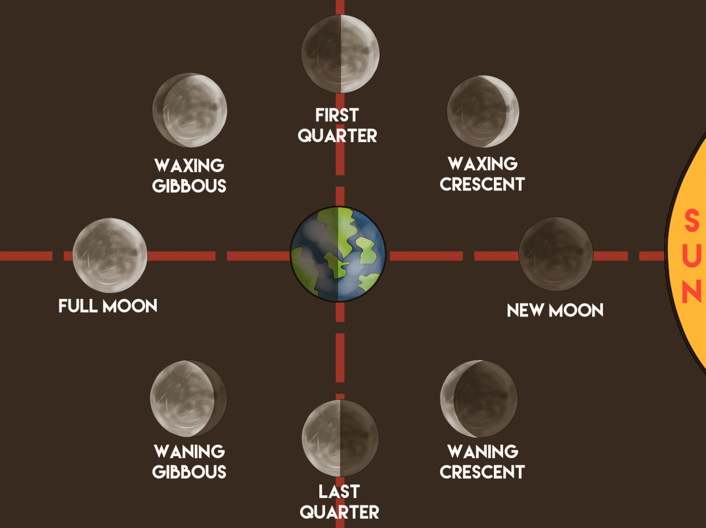CHAPTER 7 STARS AND THE SOLAR SYSTEM
CELESTIAL OBJECTS
The objects in the sky including the stars, the planets and the satellites are all known as celestial objects.
THE MOON
The phases of the moon are:
CELESTIAL OBJECTS
The objects in the sky including the stars, the planets and the satellites are all known as celestial objects.
THE MOON
The phases of the moon are:
The moon is visible only because it reflects the light of the sun. it does not have any light of its own.
The moon does not have any atmosphere. Its surface has craters and high, steep mountains as well.
THE STARS
The stars are celestial objects which emit their own light. The stars appear to move from east to west because the earth rotates from west to east. There is a star, however, that does not appear to move. This star is called the pole star.
CONSTELLATION
A group of stars forming a recognisable form is known is called a constellation. Some the most known constellations are the Great Bear, the Orion, the Leo Major.
THE SOLAR SYSTEM
The sun and the celestial bodies around it form the solar system.
The planets in the solar system include Mercury, Venus, Earth, Mars, Jupiter, Saturn and Neptune. These planets revolve around the sun in a definite path called the orbit.
SATELLITE
A celestial body revolving around another celestial body in called its satellite. Moon is earth’s satellite.
ASTEROIDS
These are small rocks orbiting the sun. These fill the gap between the orbits of Mars and Jupiter.
COMETS
A comet generally can be seen having a bright head with a long tail. The tail of the comet is always away from the sun.
METEORS AND METEORITES
A meteor is a small object that enters the earth’s atmosphere. The friction it encounters in the atmosphere heats it up and it starts burning. It evaporates within seconds.
Some meteors are large enough to not evaporate completely before reaching the earth’s surface. These bodies that reach the earth’s surface are called meteorites.
The moon does not have any atmosphere. Its surface has craters and high, steep mountains as well.
THE STARS
The stars are celestial objects which emit their own light. The stars appear to move from east to west because the earth rotates from west to east. There is a star, however, that does not appear to move. This star is called the pole star.
CONSTELLATION
A group of stars forming a recognisable form is known is called a constellation. Some the most known constellations are the Great Bear, the Orion, the Leo Major.
THE SOLAR SYSTEM
The sun and the celestial bodies around it form the solar system.
The planets in the solar system include Mercury, Venus, Earth, Mars, Jupiter, Saturn and Neptune. These planets revolve around the sun in a definite path called the orbit.
SATELLITE
A celestial body revolving around another celestial body in called its satellite. Moon is earth’s satellite.
ASTEROIDS
These are small rocks orbiting the sun. These fill the gap between the orbits of Mars and Jupiter.
COMETS
A comet generally can be seen having a bright head with a long tail. The tail of the comet is always away from the sun.
METEORS AND METEORITES
A meteor is a small object that enters the earth’s atmosphere. The friction it encounters in the atmosphere heats it up and it starts burning. It evaporates within seconds.
Some meteors are large enough to not evaporate completely before reaching the earth’s surface. These bodies that reach the earth’s surface are called meteorites.

